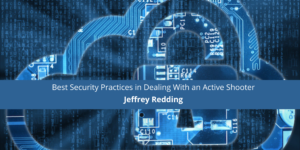Jeffrey Redding on Best Security Practices in Dealing With an Active Shooter


Jeffrey Redding, Chicago, served as an investigator with the Chicago PD for over 20 years and as an investigator with numerous Inspector Generals Offices and the Office of Internal Affairs. He served as Director of Operations for Chicago-based Security firms where he was in charge of recruitment, retention, and training of security officers. He is currently the director of security for a large retail operation in Pennsylvania. Over his long career in law enforcement and security, he has developed a reputation for expertise in effective anti-active-shooter response tactics and best practices.
We sat down with Jeffrey Redding to learn more about his insights into how security and police personnel can best deal with an active shooter situation.
Jeffrey Redding Chicago on Best Security Practices in Dealing With an Active Shooter
Jeffrey Redding, Chicago resident, explained that there are two common approaches to security policy; a one size fits all policy and a risk-based policy. He says that a risk-based policy is usually considered superior because it improves the performance of guards, allows for greater flexibility in response actions, and can be tailored to suit a specific floor plan. He named several key aspects of best practices for dealing with an active shooter, some preventative/preparatory, and some responsive.
Know Your Floor Plan
No security personnel should ever be in a situation where he does not know what type of space is around the corner. All guards should tour the facility regularly, preferably after hours, to develop a habitual awareness of the floor plan and contents of the structure.
Visibility is Deterrence
Guards should be positioned in places where they are highly visible. They should be clearly uniformed and openly armed when possible.
Accept, Monitor, Inform
Jeffrey Redding Chicago native goes on to explain, when an active shooter event begins, the fact should be accepted as a reality at as early a point as possible. Security should use any available technology to survey the shooter. These could be drones, stationary cameras, witness statements, and the observations of guards. All information on the attacker should be disseminated thoroughly, instantly, and constantly.
Scout Cover & Concealment
As part of the risk-based security policy, police and security have a duty to use intelligence acquisition tactics as an active protective
measure. Using both cover and concealment, security should aggressively pursue information about the attacker. Cover and concealment may include two-way mirrors, tinted glass, cameras, and drones.
Deploy Force Multipliers Early
Any material or tactical advantage teams have at their disposal should be deployed using the guidance of verified intelligence on the shooter. The shooter should be overwhelmed rapidly and decisively.
Jeffrey Redding, concluded by emphasizing the importance of regular training in developing a functioning response capability. He says, “People will do what they have practiced, not what they have been told.” This, he says, means scenario-based training is the best tool you can give any security or law enforcement man or woman.
